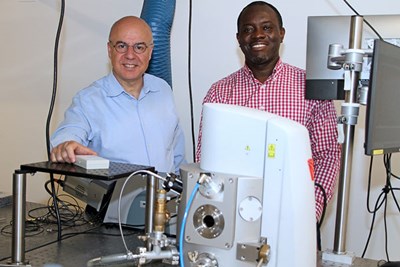More than 40 Researchers Share Work on Optical Spectroscopy and Imaging Applications for Cancer Diagnostics
 Image by Brooke Coupal
Image by Brooke Coupal
05/17/2023
By Staff
In a recently published 560-page book edited and co-authored by Kennedy College of Sciences Dean and Physics Prof. Noureddine Melikechi, researchers describe the way they are using light to identify early signs of cancer – the second-leading cause of death in the United States, according to the Centers for Disease Control and Prevention.
“By studying sunshine, we know a great deal about the sun without ever seriously considering going there. This is possible because light has distinctive fundamental properties that we have learned to harness. These properties also provide information and knowledge on the nature of biomedical tissues and fluids, which could help to combat cancers,” Melikechi says.
Optical spectroscopy and imaging are fields of physics concerned with finding, understanding and using nature’s fingerprints provided by light. With a greater understanding of the interaction of light with biomedical samples and the recent advances in technology, researchers are working to identify accurate fingerprints that help distinguish healthy biomedical samples from cancerous ones.
The 16-chapter book, titled “Optical Spectroscopy and Imaging for Cancer Diagnostics: Fundamentals, Progress, and Challenges,” consists of three parts. The first provides the fundamentals of atomic, molecular and optical physics, biomedical optics, cancer biology, optical instruments and machine learning in the context of cancer diagnostics. These elements of science are the building blocks behind the applications described in the second and third parts of the book, which focus on the applications (in some cases combined with machine learning) of optical spectroscopy and imaging in cancer diagnosis.
“The book puts all this information together and shows how fields that are seemingly different and independent are brought together to address one of the biggest health challenges we face – cancer,” Melikechi says.
The book, which is intended for graduate students, postdoctoral fellows and researchers interested in the application of light in identifying signs of cancer, provides the reader with an updated view of where the research stands in optical spectroscopy and imaging. It’s an invitation to think more about what light can tell us about diseases, Melikechi says.
Graphic design junior Rebecca Loechler of Brookline, Massachusetts, assisted Melikechi with the cover art for the book, which features a wave of different colors to showcase the spectrum of light.
“It is really a gift to have my artwork published on the cover of this scholarly work,” she says. “I love using artwork to make complex subjects more accessible, and having the opportunity to do it with such a profound publication was a special experience.”
Melikechi is a fellow of the American Association for the Advancement of Science, Optics and the American Physical Society.

